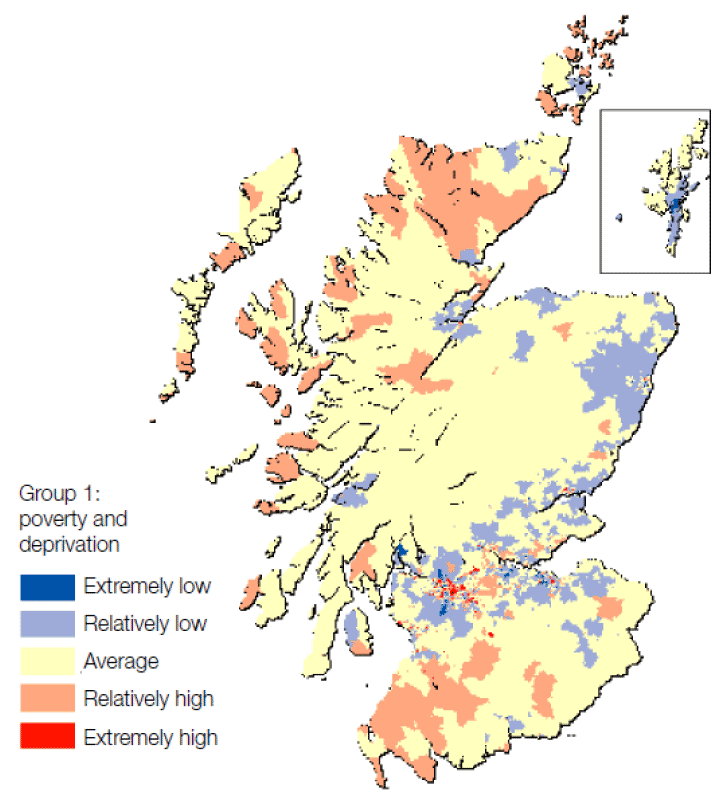Mapping Flood Disadvantage in Scotland 2015: Methodology Report
This report describes the methods applied in developing the flood disadvantage dataset for the project Mapping Flood Disadvantage in Scotland 2015.
7. Alternative vulnerability assessment methods
To date, no methodological 'best practice' has been established for the assessment and mapping of social vulnerability to flooding and to climate-related events more broadly (Preston et al., 2011). Whilst the underlying causes of social vulnerability to extreme weather events (such as age, health or living conditions) are well-recognised, the selection of indicators, methods of combining them and spatial representation may vary considerably. They depend on how vulnerability is defined; whether the assessment pertains only to people vulnerable in a crisis, or whether it also takes into account the vulnerability affecting the ability to prepare for or recover after the flood event.
Whilst spatial mapping of the vulnerability of people to extreme weather events has been the subject of multiple studies in North America, fewer such studies have been undertaken to date in the UK context (Kazmierczak and Cavan, 2011; Haynes et al., 2008; Lindley et al., 2006; Tapsell et al., 2002).
The Social Flood Vulnerability Index (SFVI) developed by Tapsell et al. (2002) is still being used in assessments of vulnerability. It uses three social characteristics and four financial deprivation indices:
- Social Characteristics:
• Long Term Sick
• Lone Parents
• Elderly (over 75 years old) - Financial Indices:
• Unemployment
• Overcrowding
• Non-car ownership
• Non-home ownership.
Therefore, SFVI when compared to the assessment described here, focuses mainly on the themes of age, health and income (although non-car ownership also relates to mobility and non-home ownership reflects the vulnerability of tenants). SFVI has been used as one of the indices in NFRA assessment (SEPA, 2011), contributing to the receptor group 'health'. This well-recognised approach helps to identify some socially vulnerable areas. However, the assessment of social vulnerability to flooding used here goes further and attempts to represent a number of other issues through relevant indicators, from the ability to use the information provided to the qualities of the physical environment that enable targeting of measures before, during and after flood events. Other advantages of the approach used here over SFVI can be seen, firstly, in the dissagregation of the final index into the dimensions of vulnerability and secondly, in the combination of vulnerability and flood hazard-exposure into a disadvantage index.
As well as the selection of the indicators, the method of combining them together is also open to debate. Some studies - similar to the assessment carried out here - add different weighted or unweighted indicators together, resulting in one overall index (e.g. Tapsell et al., 2002; Cutter et al., 2000; Chakraborty et al., 2005; Haynes et al., 2008; Wu et al., 2002); others use factor analysis or similar data reduction methods to organise the indicators (Clark et al., 1998; Cutter et al., 2003; Kazmierczak and Cavan, 2011). In particular, Principal Component Analysis (PCA) can be helpful as a means of identifying key underlying components which help to explain a larger dataset. The basic assumption made by PCA is that a few underlying components or factors within the data can be used to explain complex relationships between the whole dataset. These factors can then be mapped and combined into an index (e.g. Cutter et al., 2003).
As an alternative perspective to the main assessment of social vulnerability to climate change, Lindley et al. (2011) used PCA to identify socially vulnerable groups in Scotland, i.e. based on composite factors which helped to explain most of the variation seen across Scottish neighbourhoods. The analysis found 5 groups:
- Poverty and deprivation (shown in Figure 5);
- New arrivals - measures associated with transience of communities and lack of local knowledge;
- Work and work-related transport - related to distance to work and reliance on public transport;
- Age and household composition; and,
- Poorer social networks[10].
Factor analysis retains some information about the underlying causes of vulnerability, therefore it has an advantage over methods of assessment that develop one cumulative index only. However, the grouping of indicators according to statistical associations between them may result in rather cumbersome indices, grouping a variety of different issues together, which as a result are too far removed from the practitioners' perspective to be easily applicable. The approach presented here aims to avoid these pitfalls and categorise the indicators into topical groups, or domains, which may be easier to decipher by practitioners without losing the richness of data.
Figure 5. An example of a map representing an underlying factor of vulnerability: 'poverty and deprivation' (Lindley et al., 2011).

Source: Boundary data: EDINA UKBORDERS, Crown copyright
Contact
Email: Carol Brown
There is a problem
Thanks for your feedback